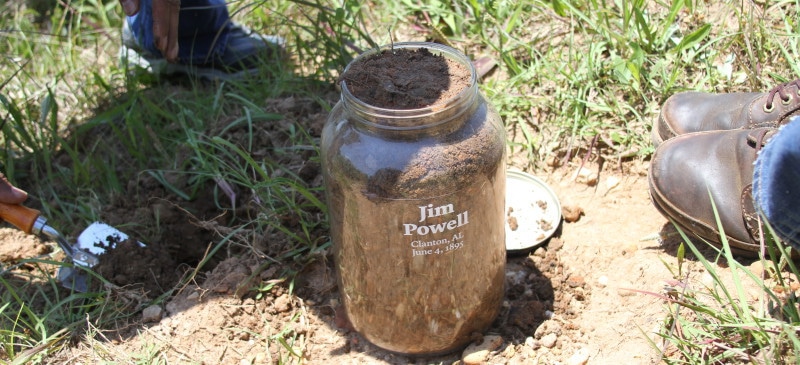Ruth examines America’s repugnant history of lynchings and a project to remember its victims. A timely reminder of where we must refuse to return to.
It’s a sunny day in Thorsby, a small town in rural Alabama. Trailers replace houses on Peachtree Drive, as the meandering dusty road turns into a dirt track. It leads to a lake, trees lining its banks. The serenity of this place – rippling water, rustling trees and a clear blue sky – belies its ugly past. Approximately 120 years ago, a young man by the name of Jim Powell was violently lynched here. It must have been hot then too, one of those sweltering summer evenings, when Powell, an African-American farm hand, accidentally entered the room of 15-year-old Mary Bussey. She screamed and he ran. Some hours later, his lifeless, badly battered body dangled from a tree at this lake. Her father, a wealthy farmer, had rounded up a posse of angry white men who had hounded down and lynched the young man.
John B. Smith, a tall 73-year old man, is on his knees. He is digging vigorously with a small shovel. “We recognize that you have lived, Jim Powell, and we feel your pain,” he says. He deposits some earth in a big glass jar. Jim Powell’s name is written on the jar as well as the date he died (4 June 1895) and the place where he was lynched. “The world now knows that you lived.”
Smith is a civil rights activist from Atlanta who is participating in the Soil Collection Project of theEqual Justice Initiative (EJI) in Montgomery. The Soil Collection Project aims to involve people in the remembrance of lynching victims, an oft forgotten group. Smith, who was now collecting the earth, and I had met at the EJI’s office a few hours prior, before heading out to Thorsby with a big glass jar with Powell’s name on it.
Starting around 1870, soon after slavery was abolished, until 1950, when the civil rights movement grew into a force to be reckoned with, African Americans, mainly men, were regularly hunted, tortured, shot, stabbed and beaten by a vengeful posse, usually because they were suspected of raping a white woman. But more minor transgressions also caused the bloodthirsty masses to rip apart black bodies: “disrespectfully” or failing to address a white woman or not stepping down from the sidewalk when a white woman approached were considered crimes punishable by death.
As journalist and activist Ida B Wells pointed out in her book “Southern Horrors, Lynch Laws in All its Phases (1892), these accusations were often barely supported by facts, but rather fuelled by the hysterical fear of “miscegenation,” interracial relationships. She wrote in 1892: “The dark and bloody record of the South shows 728 Afro-Americans lynched during the past eight years.” Only one third of those victims had been charged – not found guilty – with rape. The rest were tortured to death because of a perceived need to protect the “honour” of the white woman. However, “the white man is free to seduce all the colored girls he can,” Wells wrote.
The federal government ignored the problem and did not enforce anti-discrimination laws. President Theodore Roosevelt even implicitly approved of the lynchings when he said in 1906 in his State of the Union address: “The greatest existing cause of lynching is the perpetration, especially by black men, of the hideous crime of rape–the most abominable in all the category of crimes, even worse than murder.”
Today, the Equal Justice Initiative wants to ensure that these atrocities are not forgotten. Lawyer Bryan Stevenson founded the initiative in 1994, in order to represent indigent people on death row. Nowadays, the initiative’s focus has broadened to racial justice, making sure the history of slavery, lynchings and Jim Crow laws is remembered and discussed.
At the lake, Powell’s glass jar is filled to the brim. Smith pats the light brown earth. Barely audible, he mumbles: “Which tree did they hang him from? It must be that one.” He points at an old gnarled oak tree. The trees around the lake look ominous, threatening. Was his burned, torn, damaged body dangling from a branch? Had they gouged out his eyes? Where were his family members? Had they braved the danger and tried to save him or had they fled North, like the 6 million African Americans in the Great Migration?
Old photographs taken of lynchings reveal a picnic-like atmosphere, families packed lunch and drinks, chopped off fingers were sold as souvenirs, photographs turned into post cards. The perpetrators were seldom brought to justice, and no one counted the dead.
One of the few attempts to document the scope of these racial murders is the Equal Justice Initiative’s report Lynching in America: Confronting the Legacy of Racial Terror. They found archival evidence of 4075 lynchings that took place between 1877 and 1950.
Back in his office, Equal Justice Initiative’s founder Bryan Stevenson explains that the victims of racial terrorism in the United States remain unseen and unheard. This silence has allowed a collective trauma to endure. “We hope to start a national debate that will lead to truth telling and reconciliation. By visiting lynching sites, by naming the victims, ending their anonymity, we are starting that conversation,” he adds.
Stacked up on shelves against a wall in the presentation hall in the Equal Justice Initiative office are approximately 300 glass jars with the names of victims and dates they died. The collected earth will eventually be deposited in a national memorial for victims of lynchings to be built in Montgomery.
“The Germans built a monument in Berlin to commemorate the people who perished in the Holocaust and to remind everyone: never again. But in the South of the US, the history of racial terror is not tangible or visible, not acknowledged,” says Stevenson. “Here, we celebrate confederate memorial day every year. It’s a public holiday, to commemorate the soldiers who died trying to defend slavery. That’s absurd if you stop to think about it: what if the Germans would commemorate the Nazis? We are a post-genocidal society without any recognition for the atrocities of the past,” he adds.
The denial or obfuscation of the history of abuse, exploitation and exclusion of African Americans has caused an enduring maltreatment of black people in society. It hasn’t disappeared, according to Stevenson, it has merely evolved. The states where the highest number of lynchings took place, currently have the highest number of death penalty executions of African Americans. The lack of truth telling and reconciliation has also led to the mass incarceration of predominantly black men. While African Americans only represent 13% of population, more than a million of the total number of 2,3 million incarcerated people are black. The extra-judicial lynchings have been replaced by legal mechanisms, says Stevenson.

At the lake, Smith walks to the car with Powell’s jar in his arms. “He is one of us,” he says. “The inhumanity that led to his death, still exists, to this day.”
The fear of racial retribution features in Smith’s own memories, his earliest ones. “My parents were sharecroppers in Mississippi,” he relates as we drive through the swampy fields of Alabama, to bring Powell’s earth to the Equal Justice Initiative office. His parents wanted to escape the extreme poverty and so they fled, “under the cover of the night,” John remembers. “I was about four years old and I remember that we had to flee when there was no full moon, because otherwise the night watch would catch and return us to the farmer.” In those days, that could lead to a lynching.
The fear that the American government will kill African-Americans is deep seated in the black soul, says Smith. “Nowadays a lot of black people feel hounded and too many are killed by the police,” he says as he parks in front of the Equal Justice Initative’s office, housed in a former warehouse for slaves. “The difference is that no one knew who Jim Powell was in 1895. But now the whole world has heard of Michael Brown, Trayvon Martin and Eric Garner—forgetting and ignoring is no longer an option.”
Published in The Conmag
